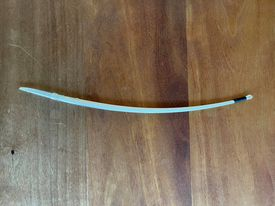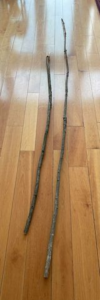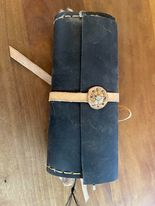A&S Research Paper #33: Early Period Fishing Kit

Our newest A&S research paper comes from Corotica merkka Senebelenae, currently queen of the East, but also a proud member of the East Kingdom Royal Foresters Guild. This paper is taken from her Forester Guild Masterwork Submission.
Corotica’s persona is a late 1st Century CE Briton of the Silures Tribe from what is now southwestern Wales. This paper describes the Fishing Kit that she has researched and recreated to reflect the technology that her persona would have carried with her while traveling.
Please click here to read the full paper.
History of Fishing
Fishing was an essential source of food in prehistory, evidence of such dating back some 500,000 years with fish fossils found during archaeological digs appearing to show that Homo habilis/Homo erectus utilized fish as a source of food. Fishing continued to develop with Homo sapiens during the Upper Paleolithic period between 40,000 and 10,000 years BCE (McIntosh, 2006, p.116). Very little is known about the different fishing practices in prehistory as much has been lost to time. Subsistence fishing at that time consisted in catching fish by hand or by using rudimentary tools made from natural materials of which no trace remains. It would have been mainly practiced by populations established near oceans, lakes and rivers (Bonsall, 2004). The spear, net, line and rod seem to have appeared almost simultaneously in Egypt around 3500 BCE (McIntosh, 2006, p.116). Subsistence fishing changed little over the centuries and some techniques are still used today in recreational fishing in the West. During Graeco-Roman Antiquity, fishing was the main subject of the Halieutika, the earliest surviving treatise on sea fishing written by the poet Oppian of Corycus.
The Romans were major consumers and traders of marine resources from the Mediterranean Basin (Sherwood, et, al, 1999). They fished mainly using different types of nets, usually using a technique called dragging, where the net was cast into the water with sinkers on the bottom and floats on top, and then hauled in (Sherwood, et. al. 1999). They also fished with hook and line, and fishhooks were found at Roman sites in England (Romano-British Somerset: Part 2, Bath, 1906).
There exists ample archaeological verification for both pre Roman and Roman-Era Indigenous Britions consuming salt and freshwater fish and mollusks as evidenced from midden pits (Locker, 2007), catching fish through the use of nets, lines, and building weirs (Robinson, 2013).
During the Middle Ages in Europe, feudal lords owned the rivers and lakes. River fishing was strictly regulated and permitted for people in religious communities whose diets were punctuated by periods of fasting. However, from the middle of the 11th century, the construction of ponds developed, heralding the beginning of fish farming. From the 15th century, deep-sea sea fishing and the trade of fish expanded. The Heidelberg Booklet from 1493, Dame Juliana Berners “A Treatise of Fishing with an Angle” in 1496, and “The Art of Angling” from 1651 further discussed detailed fishing technology and techniques regarding lines, line colors, bait, fly colors, what each fish prefers and in what time of year, prime seasons and times to fishing, but that’s all out of my time period so I’m not going to go into it here. Suffice to say that apparently people have been arguing how to fish, when to fish, what to fish with, and why the fish aren’t biting since antiquity.
The Kit

Iron spade and loop end fishing hooks of varying sizes
Extant 1st C. Roman hooks display the hook as a “spade hook”, where the end of the hook is flattened and grooved for line to be attached to (Fish Hook, The British Museum, 2019). Iron, copper-alloy, and bronze would have been the primary materials (Romano-British Somerset: Part 2, Bath, 1906; Sherwood, et, al, 1999). My spade hooks are commercially bought and iron, save for one, which I crafted myself from a small iron rod using a hammer and a steel file.
Bone gorge hook

The first direct antecedent of the fish hook was the gorge. These were horizontal, sharp pointed oval or spindle shaped bone or wood that was notched in the center so a line could be tied to it. A gorge was shoved into a chunk of bait, the fish was allowed to swallow it, and when the line was yanked, the gorge set crosswise inside the fish and he was hauled in. One of the earliest types of gorge was unearthed in a peat bed in the valley of the Somme in France, dated roughly from 7000 years ago (Edinburgh Field Naturalists, 2012). I carved the gorge hook from deer bone using a steel file and a knife. Red or Fallow deer would have been accurate for Britain, (Osbourne, 2013), but as I lack access to those animals in America, I opted for American Whitetail deer bone.
Woven linen line, dyed with walnut for camouflage in the water

I chose a woven linen line because linen was a known and available textile in 1st. C. CE Briton, and was used in fishing (Artigas & Muerza, 2002, p.17). Although the weave of such a line is unknown, I went with a commercial double twisted line as it is quite strong and mimics the method of ancient ropemaking, which is supported by impressions of cordage found on fired clay in Europe dating back 28,000 years, and fossilized fragments of two-ply laid rope, 7 mm diameter discovered in one of the Lascaux caves, dating to approximately 15,000 BCE (Glory, 1959). I then dyed it with walnut to mute the flax color to further camouflage it in the water.
Woven horsehair line

Horsehair was also used as fishing line, both braided (Artigas & Muerza, 2002, p.17) and twisted (Oppian, 2019, p 351) in Greek and Roman antiquity. Horses have a 700,000 year history in the British Isles, and by 55 BCE the Britons were highly proficient horsemen (Osbourne, 2013), so horsehair would have been available to craft into line. I made 2 lines out of horsehair procured from friends who own a horse farm nearby, one twisted, and one braided.
Steel (replacing lead), clay, stone sinkers

Roman period sinkers and weights were found all throughout the Roman Empire and were small rings or rectangles made from lead and folded onto the line (Sherwood, et.al, 1999), or drilled out stone. (Marchant, n.d.). As the use of lead sinkers is illegal due to its toxicity leaching into the water, I have opted for scavenged stone and self-crafted clay sinkers which were in use for nets (Galil, Rosen, & Zemer, 2012 p. 151-154), or commercial steel sinkers. I created one folded lead sinker for demonstration purposes.
Goose feather floats

For a float, I use whatever is available at the time, mostly opting for reed, bark, feather quills, or bits of wood. The first known mention of using a float appears in the book “Treatyse of fysshynge wyth an Angle ” written by Juliana Berners in 1496. (Berners, 2006, p.11-12). I submit that floats were used before this record as an indication that fish had taken the bait, especially considering the necessity for successful food capture, but the organic materials would not have survived into an archaeological record, particularly in Britain’s unforgiving acidic soil, therefore the float is an entirely experimental item.
Woven fish trap basket

Larger baskets would be made for catching fish and eels, and have been found in the Roman period on the mainland, particularly a find in Valkenburg, Sweden (Archaeologists unearth Roman road in Netherlands, 2018; Fish Trap, n.d.). Weirs and rock traps have been found in Britain (River Fisheries and Coastal Fish Weirs, 2018), and it is possible basket traps also existed. The laws of modern day Vermont where I live prohibit the use of basket traps for fishing all but bait minnows (Vermont Fishing Regulations. n.d.), so my trap has been scaled in accordance with those regulations and tested for minnows that populate our shoreline for the purpose of demonstration of an effective basket trap.
Fishing rod

My fishing rod is a stick. The 2nd century Greco-Roman poet Oppian speaks “go(ing) hunting, having fastened a well-twisted horsehair tied to long reed poles. Likewise others, having attached a flaxen line, cast it out from their hands” (Oppian, 2019, p 351). I feel a thin stick mimics this nicely. I have chosen an oak rod, oak being a tree native to Britain.
Fishing spear
The fishing spear is based on neolithic fishing spears (Neolithic Fishing Spear Found In Southern Denmark, 2015) whose technology has not changed much throughout time, and many primitive fish spears use similar build and technology (How To Make a Primitive Fishing Spear, 2019). I chose an all wood fishing spear over a metal tipped fishing spear (Roman Fishing Spear, 2016) because it could be easily recreated anywhere there is access to wood, should it break or become lost, and would be lighter to carry on travel than a metal tipped pole. I crafted the spear with a knife and drawing knife while the wood was still green, to work with the flexibility to create a split-spear. The spear is secured with artificial sinew, real sinew not being available to me.
Fishing net

There is ample evidence of grass, hemp and flaxen fishing nets being in use since the middle Neolithic period throughout Europe (McIntosh, 216, p 116) and well documented in Egypt and Rome using nets for fishing (Trakadas, 2006; Sherwood, et. al., 1999). Nets can be used as drag nets, casting, or set in running water as a standing trap called passive gill netting. Multiple building weaves have been recorded, a common one being the diamond knot weave where the net is woven by tying strands together into knots to form a diamond pattern (Galil, et.al., 2012), the width determining the type of fish that are being sought. My net is a commercial 10×10 cotton net, as vintage flax and hemp nets on the market are prohibitively expensive. In Vermont, only bait fish can be netted in dip nets, cast nets, and umbrella nets not exceeding a total of 51 square feet of mesh, or a seine net not exceeding 25 feet in length (Vermont Fishing Regulations. n.d.). I also wove a small piece of net to demonstrate technique and that, if need be, I could weave an entire net and perform repairs.
Knife

Finally, I carry small knives to clean and process fish. The knives are a part of my 1st century kit and are reproductions of British Roman-Age knife finds (Romano-British Knife, n.d.)
Fishing kit container
A completely experimental product, my kit is in a self-contained pouch of sheepskin sewn onto leather and rolled up. There are no extant pieces that I could discover that prehistoric fishing implements were kept in this way, but it satisfies my need to keep my equipment together and out of the elements, and rummaging fingers safe from barbs. The lanolin in the sheep wool acts as an anti-rust lubricant.
Bibliography
Archaeologists unearth Roman Road in Netherlands (2018 September 28). BBC News. Retrieved 19 April 2021 from: https://www.bbc.com/news/blogs-news-from-elsewhere-45678860
Artigas, M.U., Muerza, X.O. (2002) Bertan: The Roman Era. Retrieved December 2, 2019 from: http://bertan.gipuzkoakultura.net/eu/17/index.php
Bonsall, C (2004) Prehistoric fishing along the Danube, Antaeus. Retrieved December 1, 2019 from: https://www.academia.edu/296038/Prehistoric_fishing_along_the_Danube_2004_
Berners, J. (2010) A Treatise of Fishing with an Angle, Benediction Classics Oxford
Edinburgh Field Naturalists’ and Microscopical Society (2012) Transactions Of The Edinburgh Field Naturalists’ And Microscopical Society, Volume 2, Nabu Press (p. 468-469)
Fish Trap. (n.d.) Wikiwand. Retrieved 21 April 2021 from: https://www.wikiwand.com/en/Fish_trap
Galil, B.E, Rosen, B., Zemer, A. (2012) Ancient Fishing Gear and Associated Artifacts from Underwater Explorations in Israel – A Comparative Study. Israel Antiquities Authority and The Zinman Institute of Archaeology, University of Haifa. Retrieved December 2, 2019 from: https://pdfs.semanticscholar.org/96c1/1c941721a3312112e6e4043c24653667a43f.pdf
Glory A. (1959) Débris de corde paléolithique à la grotte de Lascaux (Dordogne), Mémoires de la Société Préhistorique Française 5, p 135-169.. Retrieved 22 April 2021 from: https://www.donsmaps.com/lascauxrope.html
Historic Fisheries and Coastal Wiers. (2018) Historic England. Retrieved 18 April 2021 from: https://historicengland.org.uk/images-books/publications/iha-river-fisheries-coastal-fish-weirs/heag226-river-fisheries-coastal-fish-weirs/
How To Make a Primitive Fishing Spear (2019) Primitive Survivors Blog. Retrieved December 2, 2019 from: https://primitivesurvivors.com/how-to-make-a-primitive-fishing-spear/
Johnson, B. (n.d.) The History of Horses in Britain. Historic UK. Retrieved 13 April 2021 from: https://www.historic-uk.com/CultureUK/The-History-of-Horses-in-Britain/
Locker, A. (2007). In piscibus diversis; the Bone Evidence for Fish Consumption in Roman Britain. Britannia, 38, 141-180. Retrieved April 22, 2021, from http://www.jstor.org/stable/30030572
Maeder, S. (2012) Gone fishing – Preliminary results of a one-man dig within the Roman settlement at Riegel, Krs. Emmendingen, Southern Germany, Museen der Stadt Wien – Stadtarchäologie. Retrieved December 1, 2019 from: https://www.academia.edu/6628891/Gone_fishing_-_Preliminary_results_of_a_one-man_dig_within_the_Roman_settlement_at_Riegel_Krs._Emmendingen_Southern_Germany
Marchant, J. (n.d.) Old Stratford – Roman and other pit finds. Old Stratford. Retrieved 18 April 2021 from: https://www.mkheritage.org.uk/os/doc/his/ro.html
Mcintosh, J. (2006). Life in Prehistoric Europe, Oxford University Press (p.116-117)
Neolithic Fishing Spear Found In Southern Denmark (2015) Archeology News Network. Retrieved December 2, 2019 from: https://archaeologynewsnetwork.blogspot.com/2015/05/neolithic-fishing-spear-found-in.html
Oppian. (2019) Halieutica, or Fishing (p 351). Harvard University Press. Retrieved December 13, 2019, from: https://www.loebclassics.com/view/oppian-halieutica_fishing/1928/pb_LCL219.351.xml
Osbourne, D. (19 September 2013). Fallow Deer in Iron Age and Roman Britain. The University of Nottingham. Retrieved 18 April 2021 from: https://core.ac.uk/download/pdf/144787731.pdf
Radcliffe, W. (1921). Fishing from the Earliest Times. Project Gutenberg. Retrieved December 2, 2019 from: https://www.gutenberg.org/files/57845/57845-h/57845-h.htm
Robinson, G. (2013 May 31). A Sea of Small Boats’: places and practices on the prehistoric seascape of western Britain.Internet Archaeology, University of York. Retrieved 21 April 2021 from: https://intarch.ac.uk/journal/issue34/2/toc.html
Roman Fish Hook (n.d.). The British Museum. Retrieved December 2, 2019 from: https://research.britishmuseum.org/research/collection_online/collection_object_details.a spx?images=true&objectId=119438&partId=1
Romano-British Knife (n.d.)The British Museum. Retrieved April 22, 2021 from: https://www.britishmuseum.org/collection/search?object=knife&place=British%20Isles&dateFrom=100&eraFrom=bc&dateTo=100&eraTo=ad&view=grid&sort=object_name__asc&page=1
Roman Fishing Spear. (2016). Ancient History Encyclopedia. Retrieved December 2, 2019 from: https://www.britishmuseum.org/collection/searchobject=knife&place=British%20Isles&dateFrom=100&eraFrom=bc&dateTo=100&eraTo=ad&view=grid&sort=object_name__asc&page=1
Sherwood, A., Milorad, K., et al. (1999) Greek and Roman Technology: A Sourcebook of Translated Greek and Roman Texts. Routledge Sourcebooks for the Ancient World. Routledge, New York.
Vermont Fishing Regulations. (n.d.). Vermont Fish and Wildlife Service. Retrieved December 2, 2020 from: https://vtfishandwildlife.com/fish/fishing-regulations
Trakadas, A. (2006). ‘Exhausted by Fishermen’s Nets’ Roman Sea Fisheries and their Management. Journal of Mediterranean Studies 16(1), 259-272. https://www.muse.jhu.edu/article/682145.
Romano-British Somerset: Part 2, Bath Pages 219-288 (1906) A History of the County of Somerset: Volume 1. British History Online. Retrieved 21 April 2021 from: https://www.british-history.ac.uk/vch/som/vol1/pp219-288
